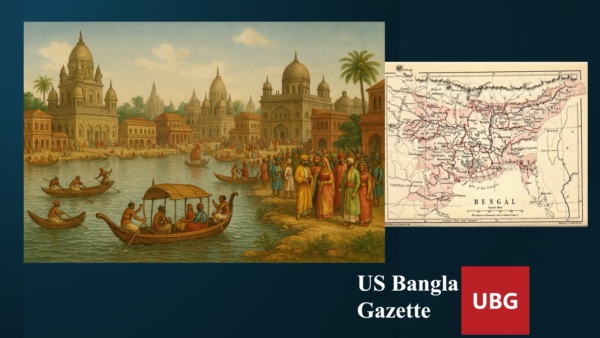Bengal’s Rich Historical Legacy: A Foundation for Bangladesh’s Modern Economic Growth

Bengal, a region with a vibrant history, has long been one of the most economically prosperous areas in the world. Bengal was a hub of culture, commerce, and intellectual achievement from ancient times through the medieval period and under the Mughal Empire. Despite periods of decline, particularly during colonial rule, Bengal’s historical legacy remains a critical foundation for the current economic growth of modern-day Bangladesh. The nation’s efforts to recover its past economic vibrancy are evident in its impressive strides in industry, agriculture, and international trade, making it one of the most dynamic economies in South Asia today.
Bengal’s prosperity dates back to ancient times. As part of the Maurya Empire (circa 3rd century BCE), Bengal played a crucial role in India’s economic and cultural development. Under Emperor Ashoka, Bengal thrived as an important trade, culture, and governance center. Pataliputra (modern-day Patna), the capital of the Maurya Empire, was strategically located to control trade routes connecting the Indian subcontinent with Central Asia, Southeast Asia, and beyond.
In the subsequent Gupta period (circa 4th-6th century CE), Bengal flourished as part of the Gupta Empire, often regarded as the “Golden Age” of ancient India. Bengal was known for its intellectual advancements, including mathematics, astronomy, and literature contributions. Additionally, its prosperity was driven by rich agricultural lands, particularly the delta regions, which are now part of modern-day Bangladesh.
During the medieval period, Bengal maintained its status as one of the world’s wealthiest and most prosperous regions. Establishing the Sultanate of Bengal (1204–1576) further cemented the region’s place as a center of political and economic power. As a major trade hub, Bengal continued, with Dhaka, the region’s capital, emerging as a major urban center. Its access to the Bay of Bengal facilitated the movement of goods between Asia, the Middle East, and Europe.
One of the key industries that propelled Bengal’s economy during this time was its textile industry, particularly muslin, a fine cotton fabric highly prized worldwide. Bengal’s textiles became synonymous with quality, making the region an essential player in global trade. Additionally, Bengal’s agricultural prosperity, fueled by fertile land and an intricate network of rivers and waterways, contributed to its growing wealth. The region was one of the top producers of rice, jute, and spices, which became important export commodities.
The peak of Bengal’s prosperity arguably occurred during the Mughal Empire (1526-1857). As one of the most economically powerful provinces in the Mughal Empire, Bengal accounted for a significant portion of the empire’s wealth. The Mughals invested heavily in developing Bengal’s infrastructure, including constructing roads, canals, and markets, which facilitated trade and agriculture.
Bengal’s textile industry flourished under Mughal rule. Muslin production reached unparalleled heights, with the fabric being exported to markets across Europe, the Middle East, and Southeast Asia. The region also produced high-quality silk and cotton fabrics, strengthening its position as a global leader in textiles.
The wealth generated from trade and agriculture contributed to developing a sophisticated urban culture. Once a regional trading hub, Dhaka became a major city within the Mughal Empire, known for its wealth, cultural contributions, and intellectual achievements. The region’s prosperity during this time was reflected in its economy, architecture, arts, and education.
Despite Bengal’s prosperous history, the arrival of the British East India Company in the 18th century and the subsequent colonial rule drastically altered the region’s economic trajectory. Once an economic powerhouse, Bengal found itself economically exploited under British rule.
The British colonizers systematically dismantled Bengal’s industrial base while extracting its wealth for the benefit of the British Empire. The jute industry, once a primary source of wealth for Bengal, was restructured to serve the needs of British trade. Bengal’s handloom industry was replaced by factory-based manufacturing, and many of the region’s agricultural products were redirected to serve the global market under British control.
While the British took advantage of Bengal’s resources, the people of the region experienced severe hardship, including famines, poverty, and political suppression. The exploitation of Bengal’s economy under British rule left the region significantly impoverished when India gained independence in 1947.
The legacy of Bengal’s historical wealth and cultural influence has been instrumental in the recovery of Bangladesh’s economy since its independence in 1971. After gaining independence, Bangladesh faced numerous challenges, including poverty, political instability, and the aftermath of a devastating war for independence. However, the country has gradually built a resilient economy, drawing from its historical strengths in agriculture, textiles, and trade.
Bangladesh is currently the second-largest exporter of garments in the world, after China. The country’s ready-made garment (RMG) industry has become a cornerstone of its economic development, providing jobs to millions of people and contributing to its growing export sector. The country’s deep-rooted tradition in textiles, dating back to the medieval period when muslin was prized, has helped Bangladesh reclaim a prominent position in the global textile market.
Bangladesh has also leveraged its historical agricultural advantages. The country is one of the largest producers of rice in the world and continues to be a significant exporter of jute. The revival of the jute industry, which was once a cornerstone of Bengal’s economy, reflects Bangladesh’s commitment to utilizing its natural resources to fuel growth.
Over the past few decades, Bangladesh has seen remarkable economic progress. With a steady annual growth rate, the country has achieved notable improvements in poverty reduction, healthcare, and education. The government’s investment in infrastructure, including ports, transportation networks, and energy, has contributed to the country’s growing industrial base and its increasing attractiveness for foreign investment.
The country’s efforts to improve social indicators have also been impressive. Bangladesh has significantly improved life expectancy, literacy rates, and gender equality. These improvements have helped create a more skilled workforce, essential for the country’s continued economic development.
Bengal’s history as an economic powerhouse, marked by a trade, agriculture, and industrial excellence tradition, has provided the foundational elements necessary for Bangladesh’s modern economic success. Despite the setbacks of colonial exploitation and political challenges, Bangladesh again emerges as a significant player in the global economy. The revival of Bangladesh’s textile industry, growth in agriculture, and increasing foreign investment reflect the country’s determination to build on its rich past.
Bangladesh’s economic resurgence is a testament to the resilience of the region and its people. The legacy of Bengal’s prosperous past is not just a historical footnote; it is an integral part of the country’s ongoing journey toward greater economic and social development. With continued investment in infrastructure, industry, and human capital, Bangladesh stands poised to reassert itself as a major economic force in the coming decades—honoring its rich heritage while embracing a future of growth and prosperity.







